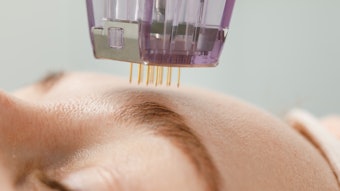
For skin care professionals, one of the major conundrums of client education revolves around sun protection, especially daily sun protection. Your clients care deeply about their skin health and appearance; they invest substantial time and money in treatments and products to keep their skin looking its best. Most know that sun protection is important. Yet when it comes to protecting their skin (and their investment) from the photoaging effects of daily UV exposure, many find it hard to take that critical step. With 80-90% of photoaging due to UV exposure, sun protection is the foundation of anti-aging.
There are many reasons for this gap, and you’ve probably heard all of them. Some clients don’t believe they personally need daily UV protection. Others attempt to get into the habit of daily sun protection, but are dissatisfied with products they’ve tried and abandon the effort. You don't want to lecture, but showing clients how the right sun protection can enhance their results and protect the investment they’ve made in their skin gives them the information they need to make a perfect sun protection choice. Correcting common misconceptions can help spark understanding of the personal benefit they will see from building daily protection into their routine. Helping them find a sun protection product they love and that fits with their routine will make all the difference in their willingness to use SPF daily and ultimately keep their skin looking younger.
The Science of Photoaging
Many clients have misconceptions about UV and its role in skin damage that come across in the reasons they give for not using daily sun protection. Do any of these excuses sound familiar?
“I don’t spend a lot of time outdoors.”
“My skin tans easily; it doesn’t burn.”
“I use SPF in my makeup.”
“I use clothing to cover up.”
“I’m only in my 20’s; my skin isn’t aging yet.”
Appreciating the role of daily protection in keeping healthy, younger-looking skin for years to come is easier when clients understand a little bit about the science of photoaging, and the role of UVA and UVB rays. Many people understand that UVB rays are “burning” rays and UVA rays are “aging” rays, but they may not understand why that’s the case.
“Photoaging” describes changes in the skin that happen after years of exposure to the sun’s UV radiation. These changes include lines and wrinkles, laxity, dark spots, rough texture, breakdown of collagen and loss of elasticity. UVA is everywhere; it makes up 95% of the UV radiation that reaches the earth’s surface. UVA rays penetrate deep into the skin, causing damage that can take years to become visible; but once visible, that photodamage can be difficult to reverse. Your client should understand that damage occurs even though they have no sunburn. Even a tan is actually a sign of damage.
UVB rays are shorter than UVA and tend to be the culprit in those painful sunburns. Both UVA and UVB rays play a role in dangerous skin cancers, so even if you never burn, broad spectrum protection is critical.
There are other differences that may surprise people. UVB rays are strongest in the summer months and during the middle of the day. That’s why it’s important to limit time in the sun during the midday hours. But UVA rays are with us all the time, 365 days a year. They penetrate glass, leading to extra photodamage on our “driver’s side”, and are the same strength from sunup to sundown all year long. There’s no better reason for using sun protection every single day!
What’s the Buzz About Mineral Sunscreens?
Often, we hear from clients that they know they “should” wear sun protection everyday, but aren’t sure which one is best for them. Outlining their options and helping sort through them makes that decision easier.
Let’s start with the sunscreen active ingredients. All sunscreens are not the same. There are two very different types of active sunscreen ingredients: MINERAL and CHEMICAL. There are just two MINERAL sunscreen ingredients: Titanium Dioxide and Zinc Oxide. These “physical blockers” act by reflecting and refracting the sun’s UV rays away from the skin, are not absorbed through the skin and do not enter the bloodstream. They act as tiny shields on the skin’s surface. Zinc oxide, in particular, is effective against a broader spectrum of UV light than any other sunscreen ingredient, so it can often be used alone.
Mineral sunscreens are very gentle and cause very few allergic reactions, making them ideal for sensitive and post-procedure skin. They don’t burn the eyes and are kind to the environment; both titanium dioxide and zinc oxide are considered reef-friendly.
All other sunscreen ingredients are CHEMICAL filters. These ingredients absorb the sun’s UV rays and, through a chemical reaction, dissipate them as heat. Unfortunately, studies have shown that these ingredients are also absorbed into the body and the bloodstream, leading the FDA to request additional safety data.
| MINERAL SUNSCREENS | CHEMICAL SUNSCREENS |
|
|
The Role of Antioxidants
Even the most dedicated daily sunscreen user will also benefit from antioxidant protection. Antioxidants provide a crucial safety net against constant exposure to UV radiation and other environmental stressors that create free radicals and ultimately lead to oxidative damage and photoaging. Free radicals are unstable oxygen molecules that have only one electron. The skin’s natural supply of antioxidants is designed to knock out free radicals before they create damage, but that supply is depleted as it is used up defending against oxidative damage.
That’s where topical antioxidants come in. These ingredients are like a second form of defense, helping to replenish the skin’s vital supply. Pairing antioxidants like vitamin C and E with sunscreen ingredients, both as additional ingredients in a daily sunscreen and as a separate antioxidant recharge, provides an extra degree of defense against photoaging.
Finding Your Ideal Mineral Sunscreen
There’s really no secret to helping your clients identify their perfect daily use SPF. Once they know the basics – minimum SPF 30, UVA/UVB and added antioxidants -- the best choice depends on their personal preferences and use. Here are a few tips:
Find a formula they LOVE. Mineral sunscreens come in many different textures and finishes. Some are silky, satiny and matte; others are moisturizing and dewy. A mineral sunscreen that looks and feels the way your client likes, that isn’t sticky or chalky and that disappears beautifully on the skin is one they’ll enjoy and want to make part of their daily routine.
Check the Active Ingredients. Turn the product around and look at the DRUG FACTS label. A pure mineral sunscreen will only have one or two active Ingredients: zinc oxide and/or titanium dioxide.
Consider the Use and the Form. Mineral sunscreens come in many forms. A cream or liquid that moisturizes or doubles as a makeup primer is ideal for daily use on the face. A stick is great for touch ups or on the backs of hands, while a lotion is a great choice for covering larger body areas. Avoid sprays that can be inhaled or get in your eyes. For clients that swim or are active, look for a water-resistant label.
Be willing to experiment. The hunt for your client’s perfect sun protection may take a little trial and error with product samples, but the reward of protecting their skin with a product they enjoy as part of their daily routine is well worth the effort.












